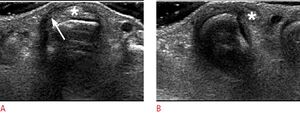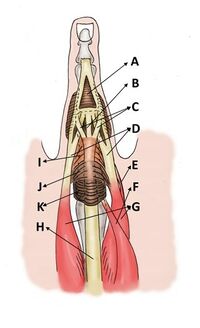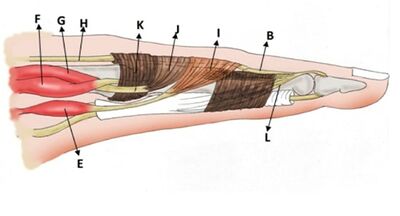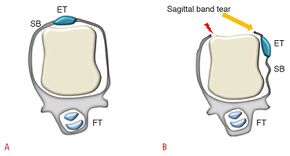Sagittal Band Injuries: Difference between revisions
m (→Anatomy) |
mNo edit summary |
||
| Line 14: | Line 14: | ||
| alt2 = | | alt2 = | ||
| caption2 = Lateral view | | caption2 = Lateral view | ||
| footer = '''Extensor mechanism of the finger'''. a: triangular ligament; b: central slip; c: slips of long extensor tendon to lateral bands; d: lateral bands; e: lumbrical muscle; f: superficial belly of dorsal interosseous muscle; g: deep belly of dorsal interosseous muscle or palmar interosseous muscle; h: long extensor tendon; i: oblique fibers; j: transverse fibers; k: | | footer = '''Extensor mechanism of the finger'''. a: triangular ligament; b: central slip; c: slips of long extensor tendon to lateral bands; d: lateral bands; e: lumbrical muscle; f: superficial belly of dorsal interosseous muscle; g: deep belly of dorsal interosseous muscle or palmar interosseous muscle; h: long extensor tendon; i: oblique fibers; j: transverse fibers; '''k: sagittal bands'''; l: oblique retinacular ligament (Landmeer’s ligament)<ref>Ditsios K, Konstantinou P, Pinto I, Karavelis A, Kostretzis L (2017) Extensor Mechanism’s Anatomy at the Metacarpophalangeal Joint. MOJ Orthop Rheumatol 8(4): 00319. DOI: 10.15406/mojor.2017.08.00319</ref> | ||
}} | }} | ||
The extensor hood is a triangular aponeurosis by which the extensor tendons insert onto the phalanges. At the dorsal aspect of the MCPJ the extensor tendons are stabilised by the extensor hood and particularly by the sagittal band during flexion and extension of the fingers. The ulnar and radial sagittal bands exert tensile forces in opposite directions during flexion, which keeps the extensor tendon in apposition with the metacarpal bone.<ref name=":0">Lee SA, Kim BH, Kim SJ, Kim JN, Park SY, Choi K. Current status of ultrasonography of the finger. Ultrasonography. 2016 Apr;35(2):110-23. doi: 10.14366/usg.15051. Epub 2015 Nov 24. PMID: 26753604; PMCID: PMC4825212.</ref> | The extensor hood is a triangular aponeurosis by which the extensor tendons insert onto the phalanges. At the dorsal aspect of the MCPJ the extensor tendons are stabilised by the extensor hood and particularly by the sagittal band during flexion and extension of the fingers. The ulnar and radial sagittal bands exert tensile forces in opposite directions during flexion, which keeps the extensor tendon in apposition with the metacarpal bone.<ref name=":0">Lee SA, Kim BH, Kim SJ, Kim JN, Park SY, Choi K. Current status of ultrasonography of the finger. Ultrasonography. 2016 Apr;35(2):110-23. doi: 10.14366/usg.15051. Epub 2015 Nov 24. PMID: 26753604; PMCID: PMC4825212.</ref> | ||
Revision as of 12:54, 6 February 2022
Sagittal band injuries (also known as Boxer's knuckle, not to be confused with Boxer's fracture) results from acute direct trauma or chronic, repetitive microtrauma, and typically occur in boxers.
Anatomy
The extensor hood is a triangular aponeurosis by which the extensor tendons insert onto the phalanges. At the dorsal aspect of the MCPJ the extensor tendons are stabilised by the extensor hood and particularly by the sagittal band during flexion and extension of the fingers. The ulnar and radial sagittal bands exert tensile forces in opposite directions during flexion, which keeps the extensor tendon in apposition with the metacarpal bone.[2]
The long extensor tendons of the posterior forearm (extensor digitorum, extensor indicis, and extensor digiti minimi) cross the MCPJ with their deepest fibres adhering partially to the posterior joint capsule and the remaining tendon bulk passing the joint. The tendons flatten and fan out as they traverse the dorsal proximal phalanx and separate into three slips.
- One central slip: inserts on to the base of the middle phalanx
- Two lateral slips: diverge laterally around the central slip to insert on the base of the distal phalanx
These slips are reinforced by the inserting tendons of the palmar/dorsal interossei and lumbrical muscles forming the extensor expansion. The extensor expansion surrounds the distal metacarpal head and proximal phalanx and serves to hold the extensor tendons in place and allow the extensors, lumbricals, and interossei to effect extension at the proximal and distal interphalangeal joints.
On the extensor surface of the thumb, there is no extensor expansion proper: the tendons of the extensor pollicis brevis and longus muscles are inserted separately in the proximal and distal phalanx respectively. However, the tendon of the extensor pollicis longus muscle does receive a fibrous expansion from the abductor pollicis brevis and adductor pollicis muscles which serves a similar purpose as the digital extensor expansion: to hold the extensor tendon in place on the dorsal phalangeal surface.[3]
Pathology
Since the sagittal band prevents deviation of the extensor tendon during flexion and bowstringing during MCP joint hyperextension, injury to the sagittal band causes extensor tendon dislocation.
The most frequent location of this injury is the third finger. The site of the tear may affect whether the extensor tendon is displaced towards the radial or ulnar side. Although the most frequent site of disruption is the radial sagittal band, such that the extensor tendon dislocates in an ulnar direction, radial subluxation can occur with forced valgus injury. Since the second and fifth fingers have two tendons per finger, they may displace in different directions, one to the radial side and the other to the ulnar side.[2]
Clinical Features
History is often of the patient punching an object with a clenched fist. Less often it can occur in non-traumatic situations such as in Rheumatoid Arthritis.
The sagittal band prevents deviation of the extensor tendon during MCPJ flexion and bowstringing during hyperextension. Therefore extensor tendon dislocation can be observed during flexion.[2]
Imaging

Ultrasound demonstrates irregular thickening of the abnormal sagittal band with hypoechogenicity. The extensor tendon can appear normal or can become swollen with loss of the fibrillar pattern, suggestive of a partial tear. On dynamic examination, the extensor tendon can be subluxed or dislocated during finger flexion in the transverse plane.[2]
References
Part or all of this article or section is derived from Current status of ultrasonography of the finger by Seun Ah Lee et al, used under CC-BY-NC
- ↑ Ditsios K, Konstantinou P, Pinto I, Karavelis A, Kostretzis L (2017) Extensor Mechanism’s Anatomy at the Metacarpophalangeal Joint. MOJ Orthop Rheumatol 8(4): 00319. DOI: 10.15406/mojor.2017.08.00319
- ↑ 2.0 2.1 2.2 2.3 Lee SA, Kim BH, Kim SJ, Kim JN, Park SY, Choi K. Current status of ultrasonography of the finger. Ultrasonography. 2016 Apr;35(2):110-23. doi: 10.14366/usg.15051. Epub 2015 Nov 24. PMID: 26753604; PMCID: PMC4825212.
- ↑ A, A., Bell, D. Extensor expansion. Reference article, Radiopaedia.org. (accessed on 06 Feb 2022) https://doi.org/10.53347/rID-70476




